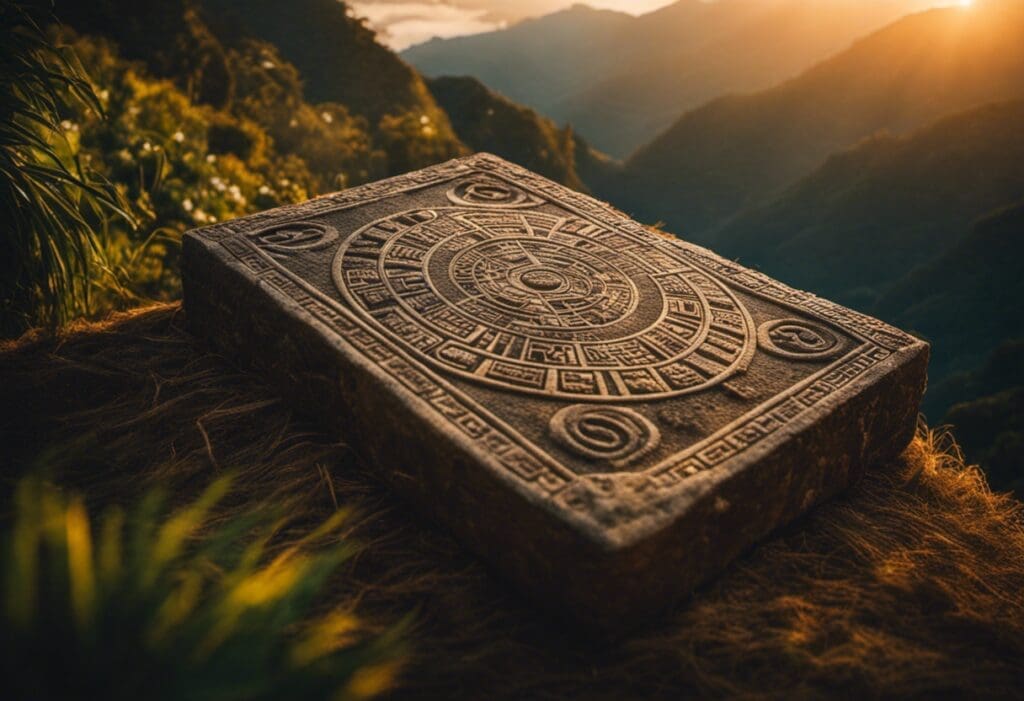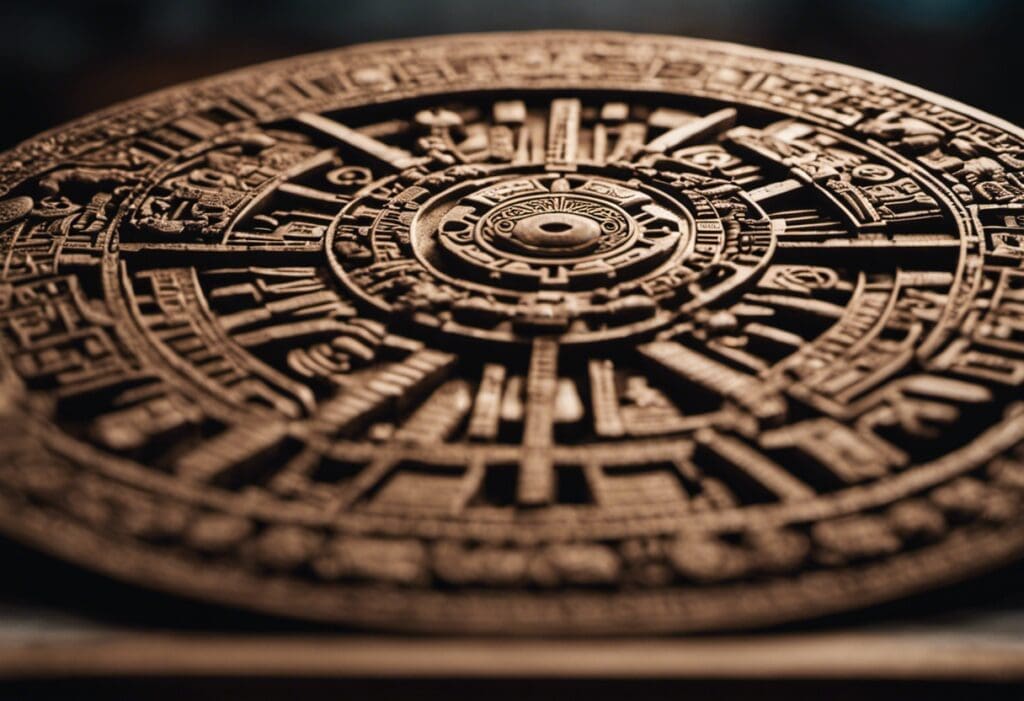The Inca calendar, a remarkable system that governed the lives of the ancient Andean civilization, holds a captivating origin story. According to historical evidence, this intricate timekeeping system was developed over 600 years ago and underwent significant evolution.
Serving as a testament to the Inca’s astronomical knowledge and advanced civilization, the calendar was deeply rooted in their religious beliefs and celestial observations.
Join us on a journey through time as we explore the origins and evolution of the Inca calendar, revealing its enduring legacy.
Key Takeaways
- The Inca calendar system was based on the alignment of the sun and the moon.
- It incorporated both solar and lunar cycles to track time and celestial events.
- The alignment of these celestial bodies was essential for agricultural planning and religious ceremonies.
- The Inca priests closely observed and interpreted these alignments to determine auspicious dates.
The Inca Civilization: a Glimpse Into the Ancient Andean Culture


The Inca civilization’s rich cultural heritage offers a fascinating glimpse into the ancient Andean culture. With a history spanning over four centuries, the Inca Empire was one of the most advanced and influential societies in pre-Columbian America. The Incas had a complex societal structure that was built on a strong foundation of religious beliefs and practices.
Ancient rituals played a crucial role in the Inca civilization, and they were deeply intertwined with their societal structure. Religion held a central place in Inca society, and the ruling elite, known as the Sapa Inca, were believed to be direct descendants of the Sun God Inti. Through various rituals and ceremonies, the Incas sought to maintain harmony with the gods and ensure the prosperity of their empire.
The Inca Empire was highly organized and governed by a hierarchical system. At the top of the social ladder was the Sapa Inca, followed by the nobility and priests. Below them were the commoners, who were primarily farmers and artisans. The Incas had a system of labor called mit’a, where individuals were required to contribute their services to the state. This collective effort ensured the smooth functioning of society and the maintenance of public infrastructure.
The Astronomical Influences: The Inca’s Connection to the Stars


With a deep reverence for the celestial bodies above, the Inca civilization forged a profound connection with the stars through their understanding of astronomy and its influence on their daily lives. The Inca calendar’s celestial connection played a crucial role in their timekeeping system and overall societal organization.
The Incas were keen observers of the night sky, meticulously studying the movements of celestial bodies such as the sun, moon, planets, and constellations. They recognized patterns and cycles in these movements, which they incorporated into their calendar system. By aligning their calendar with astronomical events, the Incas were able to accurately track the passage of time and determine important agricultural and religious events.
Celestial influences were deeply integrated into the Inca timekeeping system. For instance, the solstices and equinoxes played a significant role in determining the start of their agricultural seasons. These celestial events were crucial for planting and harvesting crops, ensuring the survival and prosperity of their society.
Additionally, the Incas believed that their rulers were descendants of the stars. They saw the celestial bodies as deities and believed that their movements and positions had a direct impact on the earthly realm. The Inca emperors, known as Sapa Incas, were seen as the intermediaries between the celestial and earthly realms, responsible for maintaining cosmic harmony.
Foundations of Time: Uncovering the Inca’s Concept of Timekeeping


By carefully studying celestial movements and incorporating them into their calendar system, the Inca civilization established a unique and sophisticated concept of timekeeping. This conceptual understanding of time was deeply rooted in their historical context and played a significant role in their society.
The foundations of Inca timekeeping can be explored through the following points:
- Harmony with the cosmos: The Inca believed that time was a cyclical and interconnected concept, closely tied to the movements of the celestial bodies. They saw themselves as part of a greater cosmic order and sought to align their actions with the rhythms of the universe.
- Dualistic perception: The Inca understood time as having both a linear and cyclical nature. They divided time into smaller units, such as days and months, while also recognizing larger cycles, such as the solstices and equinoxes.
- Religious significance: Timekeeping was intertwined with religious ceremonies and rituals in Inca society. The observation of celestial events such as eclipses and the movement of constellations played a crucial role in determining the timing of important religious events.
- Agricultural implications: The Inca calendar also served as a practical tool for agricultural purposes. By tracking the seasons and celestial events, they were able to plan their agricultural activities and ensure the success of their crops.
- Social organization: The Inca used their calendar system as a means of social organization. It helped them coordinate activities, plan festivals, and establish a sense of collective identity among their people.
The Inca’s conceptual understanding of timekeeping was deeply rooted in their historical context and had profound implications for their society. Through their careful study of celestial movements, they developed a sophisticated calendar system that served not only practical purposes but also had spiritual and social significance.
The Sun and the Moon: Key Elements in the Inca Calendar System


Incorporating the movements of the sun and the moon, the Inca calendar system relied on celestial observations to establish key elements in their measurement of time. The sun and the moon were considered vital celestial bodies in the Inca culture, and their positions and movements played a significant role in determining the Inca calendar system.
The Inca calendar was based on a combination of solar and lunar cycles. The sun, known as Inti, was considered the ruler of the day, while Mama Quilla, the moon, governed the night. The Inca people believed that these celestial bodies had a direct influence on their daily lives and activities.
To track the movements of the sun and the moon accurately, the Inca people constructed observatories at strategic locations. These observatories allowed them to observe and record the rising and setting of the sun and the moon on specific days throughout the year. They also monitored the solstices and equinoxes, which marked important agricultural events and religious ceremonies.
The Inti Raymi: Celebrating the Sun God in the Inca Calendar


The Inti Raymi, a grand festival that celebrates the Sun God, holds a significant place in the Inca calendar and culture. This ancient ceremony, also known as the Festival of the Sun, was one of the most important events in the Inca Empire. It took place annually during the winter solstice, marking the beginning of the agricultural year and honoring Inti, the Sun God.
The Inti Raymi rituals were carefully planned and performed by the Inca priests and nobles. The festival would begin with a procession from the Coricancha, the Temple of the Sun in Cusco, to the nearby fortress of Sacsayhuaman. Here, elaborate ceremonies and sacrifices would take place, including offerings of food, animals, and precious metals.
The historical significance of the Inti Raymi cannot be overstated. It served as a way to maintain social order, reinforce Inca power, and ensure the prosperity of the empire. The festival also connected the Inca people with their spiritual beliefs and provided an opportunity for communal celebration and gratitude.
The Inti Raymi continues to be celebrated to this day, albeit in a modified form. Today, thousands of people gather in Cusco each year to witness the reenactment of this ancient festival, keeping the traditions and cultural heritage of the Inca alive. It is a testament to the enduring legacy of the Inti Raymi and its importance in the Inca calendar.
- Witnessing the ancient rituals and ceremonies evokes a sense of awe and wonder.
- The grandeur of the festival transports you back in time to the Inca Empire.
- The offerings and sacrifices demonstrate the deep reverence the Inca had for the Sun God.
- The festival’s historical significance highlights the importance of the sun in Inca culture and agriculture.
- The communal celebration fosters a sense of unity and connection among the Inca people.
Adaptations and Innovations: How the Inca Calendar Evolved Over Time


Developing new methods and incorporating cultural influences were key factors in the evolution of the Inca calendar over time. As the Inca Empire grew and expanded, the need for an accurate and efficient calendar became increasingly important. The Inca civilization adapted and innovated their calendar system to meet these demands.
One of the significant adaptations in the Inca calendar was the incorporation of astronomical observations. The Inca priests and astronomers closely observed celestial events such as solstices, equinoxes, and the movements of stars and planets. This allowed them to refine their calendar and make it more precise in tracking time and predicting important agricultural events.
Another innovation in the Inca calendar was the integration of the existing lunar calendar with the solar calendar. The lunar calendar was based on the cycles of the moon and was primarily used for religious and ceremonial purposes. By combining it with the solar calendar, which was based on the movements of the sun, the Inca calendar became more comprehensive and accurate.
Furthermore, the Inca calendar was adapted to reflect the specific needs and beliefs of different regions within the empire. Local deities, agricultural practices, and cultural traditions were incorporated into the calendar, making it more relevant and meaningful to the people.
Legacy and Significance: The Lasting Impact of the Inca Calendar System


The Inca calendar system left a lasting legacy in the Andean region, influencing various aspects of Inca culture and society.
One significant impact was its cultural influence and adaptation, as the calendar system became intertwined with religious and ceremonial practices.
Additionally, the Inca calendar’s astronomical and agricultural implications were vital for the Inca civilization, as it allowed them to track celestial events and plan their agricultural activities accordingly.
Cultural Influence and Adaptation
Cultural diffusion played a crucial role in the widespread adoption and adaptation of the Inca calendar system. The Inca civilization, known for its advanced understanding of astronomy and timekeeping, influenced neighboring societies and cultures through trade, conquest, and cultural assimilation. The Inca calendar system became integrated into the daily lives of these societies, shaping their societal rituals and practices.
The lasting impact of the Inca calendar system can be seen in various ways:
- Integration into religious ceremonies, emphasizing the spiritual connection to the cosmos and the natural world.
- Influence on agricultural practices, guiding planting and harvesting seasons for optimal yields.
- Preservation of cultural identity, as the calendar system became intertwined with the cultural fabric of these societies.
- Enhanced social organization, as the calendar system provided a unified framework for coordinating activities and events.
- Continuation of the calendar system in modern times, showcasing the enduring legacy and significance of the Inca civilization.
Astronomical and Agricultural Implications
With its precise astronomical calculations and agricultural guidance, the Inca calendar system left a lasting legacy and significant impact on the societies that adopted it.
The Inca calendar was intricately connected to both the astronomical and agricultural aspects of their society. The calendar system allowed the Incas to accurately track celestial events such as solstices, equinoxes, and eclipses, providing valuable insights into the movements of celestial bodies.
This knowledge was not only used for religious and ceremonial purposes but also for practical applications, such as determining the best time for planting and harvesting crops. By aligning their agricultural practices with the cycles of the sun, moon, and stars, the Incas were able to optimize their agricultural productivity and ensure the well-being of their society.
The integration of astronomical and agricultural implications in the Inca calendar system showcases the sophistication and practicality of their civilization.
Conclusion
In conclusion, the Inca calendar stands as a testament to the ingenuity and astronomical knowledge of the ancient Andean culture.
Its origins can be traced back to the Inca civilization’s deep connection with the stars and their precise timekeeping system.
The calendar’s reliance on the sun and moon highlights the Inca’s reverence for celestial bodies.
Over time, the calendar evolved and adapted, leaving a lasting legacy and significant impact on the understanding of time.
Its rich history and cultural significance continue to evoke awe and admiration in present-day audiences.




